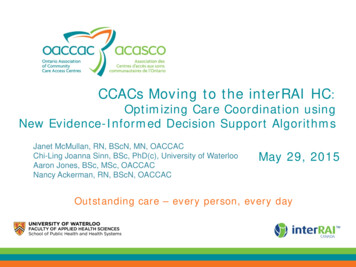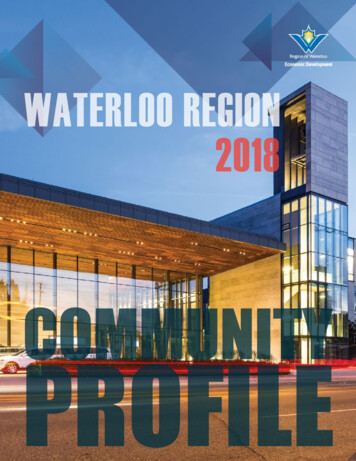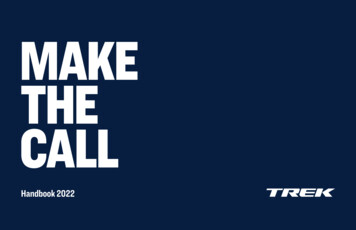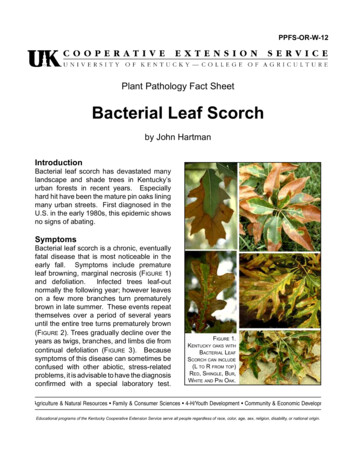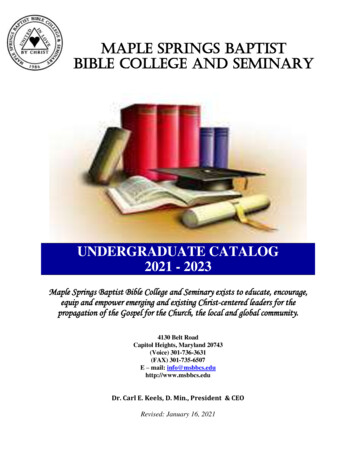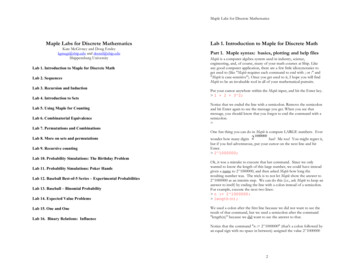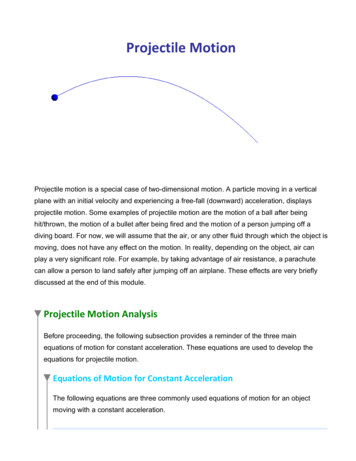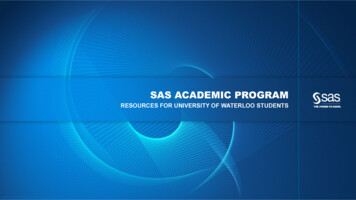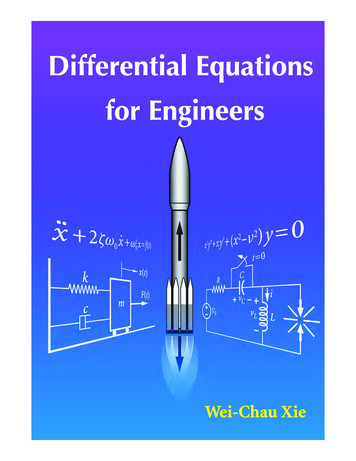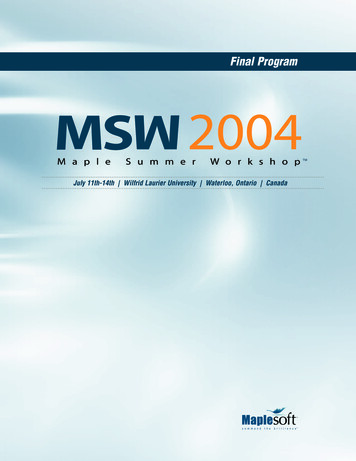
Transcription
Final ProgramTMJuly 11th-14th Wilfrid Laurier University Waterloo, Ontario Canada
Table of ContentsWelcome to MSW 2004 . . . . . . . . . . . . . . . . . . . . . . . . . . . . . . . . . . . . . . . . . . . . . . . . . . . . . . . . . . . . . . . . . . . Pg. 1Invited Speaker Biographies . . . . . . . . . . . . . . . . . . . . . . . . . . . . . . . . . . . . . . . . . . . . . . . . . . . . . . . . . . . . . . . Pg. 2Program at a Glance . . . . . . . . . . . . . . . . . . . . . . . . . . . . . . . . . . . . . . . . . . . . . . . . . . . . . . . . . . . . . . . . . . . . . Pg. 3Contributed Sessions. . . . . . . . . . . . . . . . . . . . . . . . . . . . . . . . . . . . . . . . . . . . . . . . . . . . . . . . . . . . . . . . . . . . Pg. 4-5Poster Session Participants . . . . . . . . . . . . . . . . . . . . . . . . . . . . . . . . . . . . . . . . . . . . . . . . . . . . . . . . . . . . . . . . Pg. 6Detailed Agenda . . . . . . . . . . . . . . . . . . . . . . . . . . . . . . . . . . . . . . . . . . . . . . . . . . . . . . . . . . . . . . . . . . . . . . . . . Pg. 7-12Abstracts . . . . . . . . . . . . . . . . . . . . . . . . . . . . . . . . . . . . . . . . . . . . . . . . . . . . . . . . . . . . . . . . . . . . . . . . . . . . . . Pg. 13-80
Welcome to MSW 2004Since our last gathering in the summer of 2002, many changes have occurredfor both Maple , and its parent company, Maplesoft . In fact, even the name"Maplesoft" is new since 2002!Maplesoft has grown and transformed itself in many exciting ways. It hasupdated Maple to version 9.5 with its many new features. In addition to suchenhancements as an Optimization package, or a further development of theStudent package with its visualization commands and interactive Maplet tutors,Maple 9.5 brings together enough user-friendly and "point-and-click" features thata new paradigm for the use of Maple was born. It is now possible for a user toobtain significant mathematical experiences with Maple without having to learnMaple syntax first. This opens the door to new uses of Maple by both studentsand instructors.Maplesoft has brought out a new line of related products. Maple T.A. , a testingand assessment tool powered by Maple, has been widely adopted for posing andscoring placement exams, quizzes, assignments, and even high-stakes tests. Lastmonth the Maple T.A. Building Block for providing access to all testing andassessment functionalities of Maple T.A. within the Blackboard Learning System was released. MapleNet , a protocol for interacting with Maple over the Internet, is now available. The Maple ProfessionalToolbox Series has been initiated, with the Global Optimization Toolbox as the first product in the series.New programs include MapleConnect , a third party developer program that assists our customers in commercializing andselling their Maple-related intellectual property. Initial offerings include a fuzzy-sets Maple package, an OpenMaple applicationconnecting Maple to the numeric matrix programming language GAUSS, and a set of video-based lessons for learning how tosolve problems using Maple.Maplesoft has opened new offices in the USA and Europe. The Boston office concentrates on commercial sales, and an office inSwitzerland supports European distributors .Amidst all these corporate changes, a significant personal change has altered my own life. I've retired from academe, and takena full-time position with Maplesoft, moving from the US to Waterloo, Ontario.In addition to all this growth and development, the core product Maple continues to improve, with even greater functionalityon the drawing board.At the Maple Summer Workshop, you will have the opportunity to learn first-hand about the new features of Maple and the newproducts and directions for Maplesoft. Ask questions, interact with your colleagues, provide us feedback. Get the most out ofyour time at the conference, and continue to be valuable members of the Maple community.Welcome to Waterloo. Bienvenue au Canada. Welcome to MSW 2004.Best regards,Robert J. LopezEmeritus Professor of Mathematics - RHITMathematical Applications Manager - MaplesoftProgram Chair, MSW 20041MSW2004 Final Program
Invited Speaker BiographiesDouglas B. MeadeDepartment of MathematicsUniversity of South CarolinaDouglas Meade, Ph.D., is a Professor of mathematics at the University of South Carolina. He has held the position ofUndergraduate Director of the mathematics department since 2001.Dr. Meade earned a Ph.D., in Mathematics (1989), and received an M.S. in Applied Mathematics (1986). He received a B.S.in Computer Science (1984), and a B.S. in Mathematics (1984), from Bowling Green State University.Professor Meade will discuss his journey as a mathematician using Maple technology in his talk: “Maple and its Role inthe Development of a Mathematician”, at MSW 2004.Hiroshi KomatsugawaChitose Institute of Science and TechnologyHiroshi Komatsugawa, Ph.D., is a professor at Chitose Institute of Science and Technology (CIST) in Hokkaido, Japan. Dr.Komatsugawa received his Undergraduate degree and Masters degree from Keio University in Japan. He later earned hisPh.D., in Physics from Keio University.Dr. Komatsugawa works collaboratively as one of the project leaders of a study examining regional network service in theHokkaido area. The e-learning system for mathematics developed by his research group, is used by more than 30 secondary schools across Japan.Dr. Komatsugawa will share his extensive knowledge of online math education with the MSW audience during his presentation: “E-Learning Systems for Mathematics”.L. F. ShampineDepartment of MathematicsSouthern Methodist UniversityProfessor Shampine teaches applied mathematics at Southern Methodist University in Dallas, Texas. He received a B.S. inMathematics in 1961 from the California Institute of Technology and then went on to earn a Ph.D. there, in 1964.Over the past 35 years Dr. Shampine has made significant contributions to the development of symbolic, numeric, andhybrid methods for solving ODEs while working at various academic and commercial institutions. Professor Shampine hasauthored key algorithms for both Maple and Matlab. A textbook written with two colleagues entitled "Solving ODEs inMatlab" was recently published.His presentation topic, entitled "Symbolic/Numerical Methods for ODEs" will offer insight into the issues and challenges ofcreating advanced algorithms. His talk will take the MSW audience "under the hood" of developing programs for solvingODEs numerically on a symbolic system such as Maple.Paul ThagardDepartment of PhilosophyUniversity of WaterlooDr. Thagard is a leading researcher in the field of cognitive science. He holds a Professorship at the University of Waterlooin the Philosophy department, and is cross-appointed to the Computer Science and Psychology departments.Professor Thagard is a graduate of the Universities of Saskatchewan, Cambridge and Toronto, where he earned his Ph.D.,in Philosophy (1977). He received a M.S. in Computer Science from the University of Michigan (1985). Professor Thagardhas authored several books on Cognitive Science, and his work has appeared in numerous academic journals.Dr. Thagard will give a talk entitled, "Minds and Mathematics" at the MSW 2004 banquet.2MSW2004 Final Program
Program at a GlanceSunday, July 11th* Denotes Lab ComponentTimeSession12:30 pm – 4:00 pmIntroduction to Maple*2:30 pm – 4:00 pmTechnical Q&A4:00 pm – 6:00 pmReceptionMonday, July 12thTimeSession8:30 am – 9:00 amWelcome Address9:00 am – 9:50 amInvited Speaker – L.F. Shampine10:00 am – NoonContributed SessionsNoon – 1:00 pmLunch1:00 pm – 2:00 pmMaplesoft Demonstrations and Announcements I2:00 pm – 2:30 pmThe Maple Global Optimization Toolbox2:30 pm – 5:30 pmMaple Tutorials I*5:30 pm – 9:00 pmBanquetTuesday, July 13thTimeSession8:00 am – 10:00 amContributed Sessions10:15 am – 11:05 amInvited Speaker – Hiroshi Komatsugawa11:15 am – 12:15 pmContributed Sessions12:15 pm – 1:15 pmLunch1:15 pm – 2:15 pmContributed Sessions2:30 pm – 5:30 pmMaple Tutorials II*6:00 pm – 8:00 pmMaple ChatsWednesday, July 14th3TimeSession8:00 am – 8:50 amInvited Speaker – Douglas B. Meade9:00 am – 12:15 pmContributed Sessions12:15 pm – 1:15 pmLunch1:15 pm – 2:30 pmPoster Session2:30 pm – 3:30 pmMaplesoft Demonstrations and Announcements II3:30 pmConference ClosingMSW2004 Final Program
Contributed SessionsDenotes a presenter who will participate in the poster session, in addition to contributed session. PresenterMath Mathematics ResearchPresenter NameAbbasian /Ed EducationSci Science, Engineering and ComputingTopicDay TimeLocationTrack Page NoIonescuExploring Some Common Misuses of Maple in UndergraduateMathematicsT8:00 AMBAB 209Ed14AbeEssentials of PDEs in Mathematical Physics Using Maple 9M10:00 AM BAB 209Ed15Anand et alTarget Recognition Algorithm Employing Maple CodeGenerationW10:45 AM BAB 211Sci16-17Visualization of Topics in Partial Differential Equations Using MapletsM10:30 AMBAB 209Ed18-19AttanucciGetting "Old Dogs" to do "New Tricks": Using CommunityCollege Mathematics (and Maple) to Create "Mathematical Art"W10:45 AM BAB 209Ed20Bicak /HospodkaAnalysis of Switched Capacitators and Switched CurrentsCircuits in MapleM10:00 AM BAB 211Sci21BremnerNon-Associative Algebra Structures on IrreducibleRepresentations of the Simple Lie Algebra sl(2)M10:00 AMBurgoyneUsing Maple to Construct and Plot a Fourier SeriesTCarvalhoPicturing the Oscillations of a Mass-Spring SystemChapmanAnco/Larrass BAB 208 Math221:15 PMBAB 211Ed23W9:00 AMBAB 209Ed24An Improved Algorithm for the Automatic Derivation and Proof ofTensor Product Identities via Computer AlgebraM10:30 AM BAB 208 Math25-26Chow /CareyConstruction of Powell-Sabin-Heindl Divergence Free BasisFunctions Using MapleT11:15 AM BAB 208 Math27CollettUsing Maple to Investigate the Poincaré Polarization Sphereand the Observable Polarization SphereT8:00 AMBAB 211Sci28CoullietteGuiding Students in How to Use Finite Difference Methods forSolving Linear and Nonlinear Boundary Value Problems in MapleM11:00 AM BAB 209Ed29deKleine et alA Sparse Modular GCD Algorithm for Handling the Non-MonicCaseM11:00 AM BAB 208 Math30Douglas /HarrisonLeast-Squares Fitting of Data from the Physical SciencesW11:15 AM BAB 211Sci31Drska /SinorInformation Physics Curriculum: E-Learning Tools and TLMCoursesW9:30 AMBAB 209Ed32-33Maplets that Display the Heat and Wave EquationsM11:30 AM BAB 209Ed34EberhartTraining Teachers to Use Maple to Prepare Classroom MaterialsW11:15 AM BAB 209Ed35Fee /MonaganCryptography Using Chebyshev PolynomialsW10:45 AM BAB 208 Math36GrotendorstComputer Mathematics with Maple - Numerical Analysis withSymbolic ComputationT8:00 AM37Hospodka /BicakSYNTFIL - Synthesis of Electric Filters in MapleM10:30 AM BAB 211Ionescu /AbbasianUse of Maple in Some New Non-Autonomous NumericalMethodsT8:30 AMBAB 208 Math40KhanshanA Maple Approach to Electrical Engineering ProblemsW9:00 AMBAB 211Sci41KraftFunctions and Parameterizations to Think WithT9:30 AMBAB 209Ed42-43Kunze /HeidlerCollage: A Maple Package Which Uses the Collage Method toSolve Inverse Problems for Ordinary Differential EquationsT9:00 AMBAB 208 MathDuchesne /Roach 4BAB 208 MathSci38-3944MSW2004 Final Program
Contributed SessionsDenotes a presenter who will participate in the poster session, in addition to contributed session. PresenterMath Mathematics ResearchEd EducationSci Science, Engineering and ComputingPresenter NameTopicMaronEfficient Web-Based Grading of Multi-Step Math, Science,andTechnology ProblemsT1:45 PMMarotiImplementing Regular Expressions in MapleT11:45 AM BAB 208 MathMcCabeDiscourse with Maple: Teaching Maple in an Interactive ClassroomT9:00 AMBAB 209Ed47-48McGuireManipulate, Solve, Visualize, QuestionW10:00 AMBAB 209Ed49Monagan /FeeA Cryptographically Secure Random Number Generator for MapleW9:30 AMBAB 208 Math50SochackiUsing Picard Iteration and Cauchy Products to Solve InitialValue Problem Ordinary Differential EquationsT9:30 AMBAB 208 Math51-52MorrisMaple Schemes for a Fractional Brownian Black-Scholes EquationT11:15 AM BAB 211Sci53NakamuraSimulation Software Integrated with Maple and JavaW11:45 AM BAB 211Sci54-55OgilviePowerful Procedures for Linear and Non-Linear Regression with MapleW9:00 AMThe PolynomialIdeals Maple PackageM11:30 AM BAB 208 MathPiatkowski /NelsonMaple and Software Engineering EducationT1:15 PMPindorQuantum Algebra PackageW11:15 AM BAB 208 Math61Pinter et alThe Maple Global Optimization ToolboxM2:00 PMBAB 101 N/A62Quaintancemxn Proper Arrays: Geometric Construction and the AssociatedLinear Cellular AutomataW11:45 AM BAB 208 Math63Redmond/McPhee Dynamics of Multibody Mechatronic Systems: SymbolicModelling with Linear Graph TheoryW9:30 AMBAB 211Sci64-65Reynoso-delValleInteractive MacroeconomicsT11:45 AM BAB 211Sci66RocheAnalytic Root Finding: A New Maple CommandT8:30 AMBAB 209Ed67Dynamics of Multibody Mechatronic Systems: SymbolicImplementation and Numeric SolutionW10:00 AM BAB 211Sci68-69SchrammExperiences Using Maple in Math Education at the HamburgUniversity of Applied SciencesT1:45 PMBAB 208Ed70SchwarzMaple T.A. Supported Learning in "Math for the Life Sciences":A First Year GrantT11:15 AM BAB 209Ed71ShaoSymbolic Computation with Maple for Eddy Current Responseto Variation in Surface Conductivity with DepthT8:30 AMBAB 211Sci72High Order Asymptotic Solutions to Free Standing Water Wavesby Computer AlgebraT9:00 AMBAB 211Sci73-74StensonMaple in High School Multivariable CalculusW11:45 AM BAB 209Ed75TeferaMultInt: A Maple Package for Multiple Integration by the WZ MethodW10:00 AM BAB 208 Math76Money /Pearce /MonaganSchmitke /McPheeShingareva /CelayaDay TimeLocationBAB 211Track Page NoEdBAB 208 MathBAB 208Ed454656-575859-60WachsmuthMaple in Disguise: Intuitive math tools using MapleNetT11:45 AM BAB 209Ed77Whitely Jr.Acid/Base Equilibrium in General Chemistry Using MapleT9:30 AMBAB 211Sci78YasskinExtrusion of Polycrystalline MaterialsM11:00 AM BAB 211Sci79-80YasskinSome Pedagogical Maplet for CalculusM11:30 AM BAB 211EdN/A5MSW2004 Final Program
Poster Session Participants6Presenter NameTopicCampbell, ColinLearning Maple 24/7 with "Maple Mastery I" On-line VideosCampbell, ColinStructured MapletsEbrahimi, Mohammad AliVisualizing Direction Fields with an Enhanced DEplot CommandLinder, DaveThe Maple Global Optimization ToolboxLo, SimonLinear algebra over general finite fields, Euclidean domains, and integraldomains in MapleMSW2004 Final Program
Detailed AgendaSunday, July 11th . . . . . . . . . . . . . . . . . . . . . . . . . . . . . . . . . . . . . . . . . . . . . . . . . . . . . . . . . Pg. 7Monday, July 12th . . . . . . . . . . . . . . . . . . . . . . . . . . . . . . . . . . . . . . . . . . . . . . . . . . . . . . . . . Pg. 8-9Tuesday, July 13th . . . . . . . . . . . . . . . . . . . . . . . . . . . . . . . . . . . . . . . . . . . . . . . . . . . . . . . . Pg. 10-11Wednesday, July 14th . . . . . . . . . . . . . . . . . . . . . . . . . . . . . . . . . . . . . . . . . . . . . . . . . . . . . . Pg. 12*Denotes lab componentBAB Bricker Academic Building (May be referred to as “Learning Centre” on some versions ofWLU campus maps)Sunday, July 11thTimeSession12:30 pm – 4:00 pmIntroduction to Maple* – An ideal way for new Maple users to learnabout basic Maple techniques. Participants will become familiarwith the Maple interface during the session. Examples of materialto be covered will include: sectioning worksheets, graphing, distinguishing between functions and expressions and creating animations.Location: BAB 4292:30 pm – 4:00 pmTechnical Q&A – Ask senior members of the Maplesoft researchand development team about newest programming, system andmathematical features in Maple.Location: BAB 1104:00 pm – 6:00 pmReception – The Wilfrid Laurier University Faculty of Science andMaplesoft, welcome you to the Maple Summer Workshop 2004.Join us for complimentary refreshments and mingle with MSWpeers.Location: Science Building, Courtyard7MSW2004 Final Program
Detailed AgendaMonday, July 12thTimeSession8:30 am – 9:00 amWelcome Address – Arthur Szabo, Dean, Faculty of Science, WilfridLaurier UniversityLocation: BAB 1019:00 am – 9:50 amInvited Speaker – L.F. Shampine, “Symbolic/Numerical Methods forODEs”Location: BAB 10110:00 am – NoonContributed SessionsSci - Loc: BAB 211Math - Loc: BAB 20810:00 am – 10:25 am Bicak, Jan - Analysis ofSwitched Capacitatorsand Switched CurrentsCircuits in Maple Bremner, Murray Non-Associative AlgebraStructures on IrreducibleRepresentations of theSimple Lie Algebra Abe, Yutaka - Essentialsof PDEs in MathematicalPhysics Using Maple 910:30 am – 10:55 am Hospodka, Jiri SYNTFIL – Synthesis ofElectric Filters in Maple Chapman, Frederick W. An Improved Algorithmfor the AutomaticDerivation and Proof ofTensor Product Identitiesvia Computer Algebra Larrass, Stefan Visualization of Topics inPartial DifferentialEquations Using Maplets11:00 am – 11:25 am Yasskin, Phil Extrusion ofPolycrystalline Materials deKleine, Jennifer A Sparse Modular GCDAlgorithm for Handlingthe Non-Monic Case Coulliette, David Guiding Students in Howto Use Finite DifferenceMethods for SolvingLinear and NonlinearBoundary Value Problemsin Maple11:30 am – 11:55 am Yasskin, Phil Some PedagogicalMaplets for Calculus Pearce, Roman - ThePolynomialIdeals MaplePackage Duchesne, Ryan andRoach, Steven - Mapletsthat Display the Heat andWave EquationsNoon – 1:00 pm1:00 pm – 2:00 pmED - Loc: BAB 209LunchMaplesoft Demonstrations and Announcements ICore product suite: Exciting news and demonstrations of thelatest versions of the Maplesoft core product line: Maple, MapleNet,Maple T.A.Location: BAB 1018MSW2004 Final Program
Detailed AgendaTimeSession2:00 pm – 2:30 pmThe Maple Global Optimization ToolboxJános D. Pintér, PCS Inc.Location: BAB 1012:30 pm – 5:30 pmMaple Tutorials I*Maple Programming IProgramming Maplets IMaple T.A. IMichael Monagan,Simon Fraser UniversityJason Schattman,MaplesoftLouise Krmpotic,MaplesoftLocation: BAB 429Location: BAB 531Location: Science Building10555:30 pm – 9:00 pm5:30 pm6:30 pm8:00 pmMaple in MathematicsEducationRobert Lopez,MaplesoftLocation: BAB 206Maple and ODEsEdgardo Cheb-Terrab,MaplesoftLocation: BAB 207BanquetCocktail receptionDinnerDinner speaker - Paul Thagard, University of WaterlooLocation: Dining Hall Building, 2nd Floor, Senate Governor’s Room9MSW2004 Final Program
Detailed AgendaTuesday, July 13thTimeSession8:00 am – 10:00 amContributed Sessions – 3 parallel tracksSci - Loc: BAB 211Math - Loc: BAB 2088:00 am – 8:25 am Collett, Edward - UsingMaple 9 to Investigate thePoincaré PolarizationSphere and theObservable PolarizationSphere Grotendorst, Johannes Computer Mathematicswith Maple – NumericalAnalysis with SymbolicComputation Abbasian, Reza Exploring Some CommonMisuses of Maple inUndergraduateMathematics8:30 am – 8:55 am Shao, S. - SymbolicComputation with Maplefor Eddy CurrentResponse to Variation inSurface Conductivity withDepth Ionescu, Adrian - Maplein Some New NonAutonomous NumericalMethods Roche, Austin D. Analytic Root Finding: ANew Maple Command9:00 am – 9:25 am Shingareva, Inna - HighOrder AsymptoticSolutions to FreeStanding Water Waves byComputer Algebra Kunze, Herb - Collage:A Maple Package WhichUses the Collage Methodto Solve InverseProblems for OrdinaryDifferential Equations McCabe, Michael Discourse with Maple:Teaching Maple in anInteractive Classroom Whitely Jr., R.V. Acid/Base Equilibrium inGeneral Chemistry UsingMaple Money, James - UsingPicard Iteration andCauchy Products to SolveIntitial Value ProblemOrdinary DifferentialEquations in Maple Kraft, Roger - Functionsand Parameterizations toThink With9:30 am – 9:55 am10:15 am – 11:05 amED - Loc: BAB 209Invited Speaker – Hiroshi Komatsugawa,“E-Learning Systems for Mathematics”Location: BAB 10111:15 am – 12:15 pm11:15 am – 11:40 am11:45 am – 12:10 pm10Contributed Sessions – 3 parallel tracksSci - Loc: BAB 211Math - Loc: BAB 208ED - Loc: BAB 209 Morris, Hedley - MapleSchemes for a FractionalBrownian Black-ScholesEquation Chow, S. - Constructionof Powell-Sabin-HeindlDivergence Free BasisFunctions Using Maple Friedhelm Schwarz Maple T.A. SupportedLearning in “Math for LifeSciences”: A First YearGrant Reynoso-del-Valle,Alejandro - InteractiveMacroeconomics Maróti, George T. Implementing RegularExpressions in Maple Wachsmuth, Bert G. Maple in Disguise:Intuitive Math Tools UsingMapleNetMSW2004 Final Program
Detailed AgendaTimeSession12:15 pm – 1:15 pmLunch1:15 pm – 2:15 pmContributed Sessions – 3 parallel tracksED - Loc: BAB 211ED - Loc: BAB 2081:15 pm – 1:40 pm Burgoyne, Janet - Using Maple toConstruct and Plot a Fourier Series Piatkowski, Thomas F. - Maple andSoftware Engineering Education1:45 pm – 2:10 pm Maron, Melvin J. - Efficient WebBased Grading of Multi-Step Math,Science and Technology Problems Schramm, Thomas - ExperiencesUsing Maple in Math Education atthe Hamburg University of AppliedSciences2:30 pm – 5:30 pmMaple Programming IIProgramming Maplets IIMaple T.A. IIMichael Monagan,Simon Fraser UniversityJason Schattman,MaplesoftLouise Krmpotic,MaplesoftLocation: BAB 429Location: BAB 5316:00 pm – 8:00 pmLocation: Science Building1055Maple in the PhysicalSciencesRobert Corless, Universityof Western OntarioLocation: BAB 207Maple Packages:Creation andDistributionJames McCarron,MaplesoftLocation: BAB 206Maple Chats – A series of parallel sessions. You’ll get a glimpse ofwhat goes into the development of Maple software and will have anopportunity to make comments and suggestions to members of theMaplesoft Research and Development team.Worksheet InterfaceMaple on the WebNumeric ComputationsMaple InternalsKevin Ellis, MaplesoftLouise Krmpotic and JamesMcCarron, MaplesoftDavid Linder, MaplesoftPaul DeMarco, MaplesoftLocation: BAB 208Location: BAB 209Location: BAB 21111Maple Tutorials II*- 5 parallel tracksDevelopingApplicationsPaul Mansfield,MaplesoftLocation: BAB 210Location: BAB 112MSW2004 Final Program
Detailed AgendaWednesday, July 14thTimeSession8:00 am – 8:50 amInvited Speaker – Douglas B. Meade, “Maple and its Role in theDevelopment of a Mathematician”Location: BAB 1019:00 am – 12:15 pmContributed Sessions – 3 parallel tracksSci - Loc: BAB 211Math - Loc: BAB 208 Khanshan, Amir Hussein- A Maple Approach toElectrical EngineeringProblems Ogilvie, J.F. - PowerfulProcedures for Linear andNon-Linear Regessionwith Maple Carvalho, M. Juliana Picturing the Oscillationsof a Mass-Spring System McPhee, John Dynamics of MultibodyMechatronic Systems:Symbolic Modelling withLinear Graph Theory Monagan, Michael - ACryptographically SecureRandom NumberGenerator for Maple Drska, L. - InformationPhysics Curriculum: ELearning Tools and TLMCourses Schmitke, Chad Dynamics of MultibodyMechatronic Systems:Symbolic Implementationand Numeric Solution Tefera, Akalu - MultInt:A Maple Package forMultiple Integration bythe WZ Method McGuire, George Manipulate, Solve,Visualize, Question10:45 am – 11:10 am Anand, Christopher Target RecognitionAlgorithm EmployingMaple Code Generation Fee, G.J. - CryptographyUsing ChebyshevPolynomials Attanucci, Frank J. Getting “Old Dogs” to do“New Tricks”: UsingCommunity CollegeMathematics (and Maple)to Create “MathematicalArt”11:15 am – 11:40 am Douglas, Solomon R.C.- Least-Squares Fitting ofData from the PhysicalSciences Pindor, Andrzej Quantum AlgebraPackage Eberhart, Carl - TrainingTeachers to Use Maple toPrepare ClassroomMaterials11:45 am – 12:10 pm Nakamura, Yasuyuki Simulation SoftwareIntegrated with Maple andJava Quaintance, Jocelyn mxn Proper Arrays:Geometric Constructionand the Associated LinearCellular Automata Stenson, Ellen - Maplein High SchoolMultivariable Calculus9:00 am – 9:25 am9:30 am – 9:55 am10:00 am – 10:25 am12:15 pm – 1:15 pmLunch1:15 pm – 2:30 pmPoster SessionLocation: Science Building, CourtyardED - Loc: BAB 209Maplesoft Demonstrations and Announcements II2:30 pm – 3:30 pmAdd-on products and new technologies: see the latest add-on products and sneakpreviews of some of the exciting new technology initiatives from Maplesoft.Location: BAB 1013:30 pm12Conference ClosingMSW2004 Final Program
Abstracts13MSW2004 Final Program
Exploring Some Common Misuses of Maplein Undergraduate MathematicsReza O. Abbasian1 Adrian Ionescu2In this paper we will investigate some of the common misuses and misinterpretations of thesoftware when used as a tool in teaching undergraduate mathematics. This work is an extensionof our previous paper on the use of Maple in teaching undergraduate mathematics. The readermay want to consult our earlier paper, Case studies in the Shortcomings of Maple in TeachingUndergraduate Mathematics, which was published in the proceedings of the 2nd InternationalConference on the Teaching of Mathematics (ICTM2). Also, The reader may want to consult asecond paper, Shortcomings and Misuses of Technology (Maple, TI calculators) inUndergraduate Mathematics,by Abbasian and Sieben, which was published in the proceedingsof the 16th Annual International Conference on Technology in Collegiate Mathematics (ICTCM).Here, we will present examples where Maple produces correct, but somewhat incomplete, resultsthat are misused or misunderstood by novice users of the software, specifically the undergraduatestudents. The authors have over a decade of experience in using Maple as a teaching tool andwholeheartedly endorse the CAS-based mathematics instruction. Some examples presented hereare based on our classroom experiences. Other cases have been reported by our students, by ourcolleagues and in various newsgroups devoted to discussions on Computer Algebra Systems(CAS). Many of the previously reported software inadequacies, observed in the earlier versionsof Maple, are now corrected in the most recent releases of the software. So, although we haveoccasionally referred to the older versions, we have presented the actual output only from thelatest version of Maple (Maple 9) in the examples presented here. We have many examples atour disposal; however, for the sake of brevity, we have limited our discussions to the examplesrelated to the topics that are ordinarily covered in the first few years of a typical undergraduatemathematics curriculum, topics such as limits, differentiation, single and multivariableintegration, series, optimization and ordinary differential equations. We have also tried to limitour case studies to the most common features of Maple, specifically those features that arewidely used by the undergraduate students who are new to Maple.Keywords: Maple, technology, misuse, bugs, undergraduate mathematicsIntended audience: Undergraduate mathematics instructorsTheme: Maple in education1Texas Lutheran University, Department of Mathematics and Computer Science1000 W.Court Street, Seguin, Texas, 78155 USARabbasian@tlu.edu2Wagner College, Department of Mathematics and Computer ScienceStaten Island, New York, 10301 USAIonescu@Wagner.edu14MSW 2004 Final Program
Essentials of PDEs in Mathematical Physics Using Maple 9Yutaka Abe1The method of separation of variables is one of the most popular analytical methods for solvinglinear partial differential equations (LPDEs). The Fourier series method for ordinary differentialequations is easily extended to the solution of LPDEs in mathematical physics. The heat (ordiffusion) equation, the wave equation for vibrating strings, and Laplace’s equation can betreated with minimal mathematical knowledge. Students in physics and engineering are morefamiliar with physical rather than abstract mathematical constructs, so the author will explainhow to express selected physical processes in suitable mathematical language. Maple 9 is mosthelpful in this regard.Section 1 provides derivations of the basic partial differential equations that often appear inmathematical physics. Section 2 explains the decoupling of the LPDEs into a pair of ordinarydifferential equations. Section 3 discusses the Green’s function approach to LPDEs, one of themore powerful methods for obtaining the solution of complex partial differential equations.In the real world, however, most physical phenomena cannot be described by linear equations. In thelast section, the author, aided by the numerical solution of difference schemes, introduces some specifictechniques for treating several nonlinear differential equations.1Hokkaido Automotive Engineering College15MSW 2004 Final Program
Target Recognition Algorithm Employing Maple Code GenerationChristopher Anand 1 Jacques Carette 2 Alexandre Korobkine 3 Mark Lawford 4In visual tracking applications, a series of images captured from CCD cameras must be processedin real-time to extract information about spatial position. This information can be used for targetidentification, object measurement, and closed-loop target acquisition. In some applications, thetarget has a high degree of regularity, and can be modeled mathematically. In our immediateapplication, the target is a user-generated pattern, so we are free to design it with this property.The recognition of patterns with mathematical descriptions can be efficiently modeled as anoptimization problem, and recognition can be implemented as a solver, which in addition toestimating model parameters, can assign a likelihood to the estimates. Advanced model-basedcontrollers can make use of the likelihood information to improve the robustness of the controllerto random and systematic noise sources.Although there are many advantages to mathematical modeling and optimization-based parameterextraction, such methods are expensive both in terms of run-time computation and softwaredevelopment. The expense comes proliferation of software from two sources: freedom inchoosing the target pattern/model, need to develop multi-stage solvers to achieve convergencerequirements for the highly-nonlinear models which result.To solve this
Initial offerings include a fuzzy-sets Maple package, an OpenMaple application connecting Maple to the numeric matrix programming language GAUSS, and a set of video-based lessons for learning how to solve problems using Maple. Maplesoft has opened new offices in the USA and Europe. The Boston office concentrates on commercial sales, and an .
